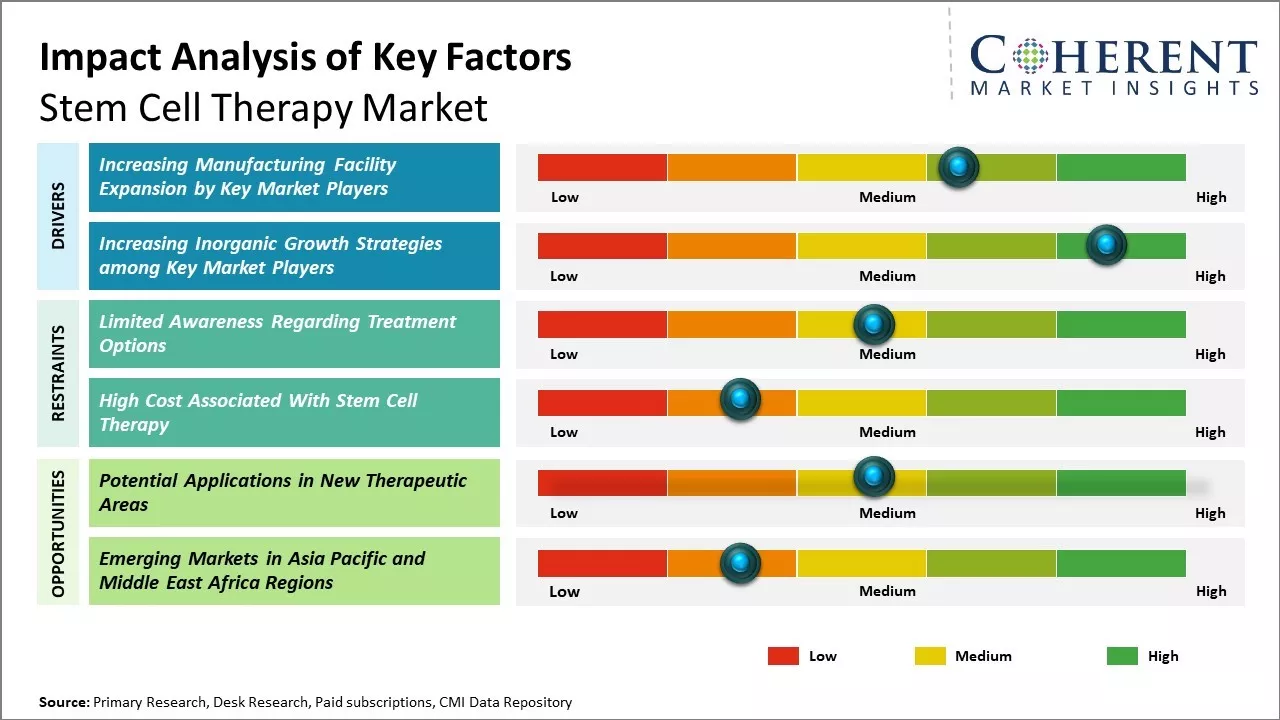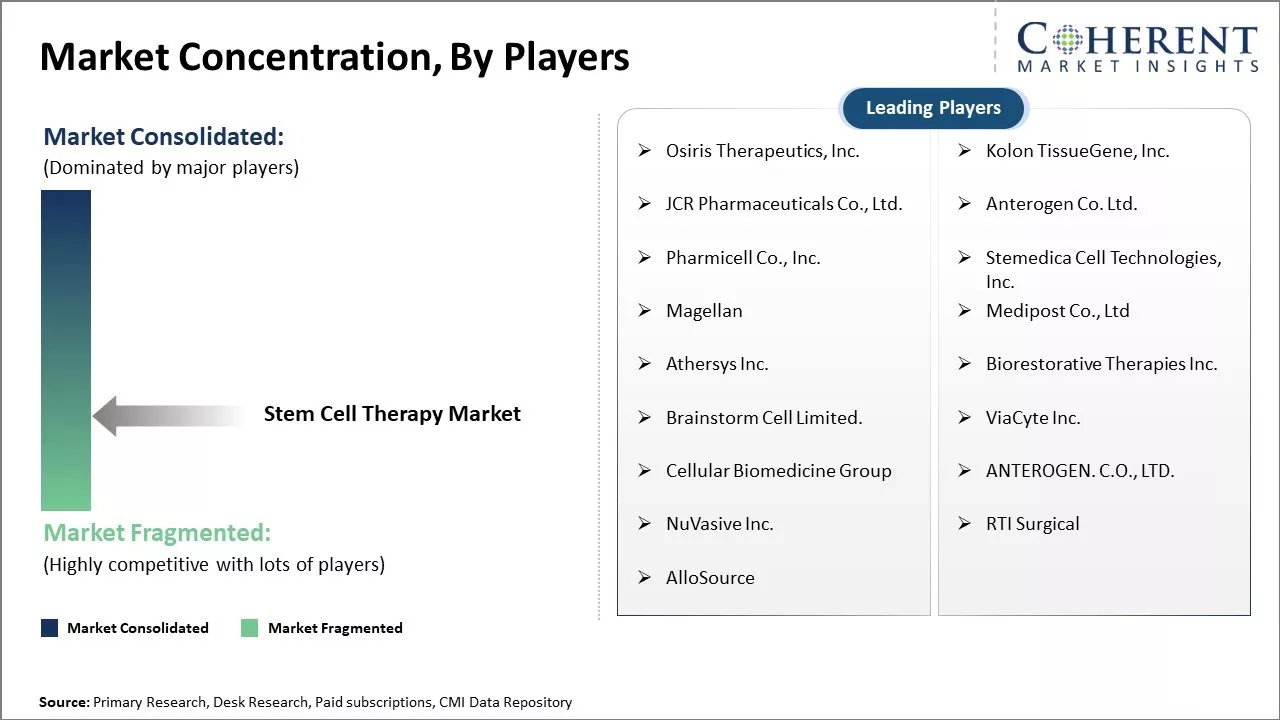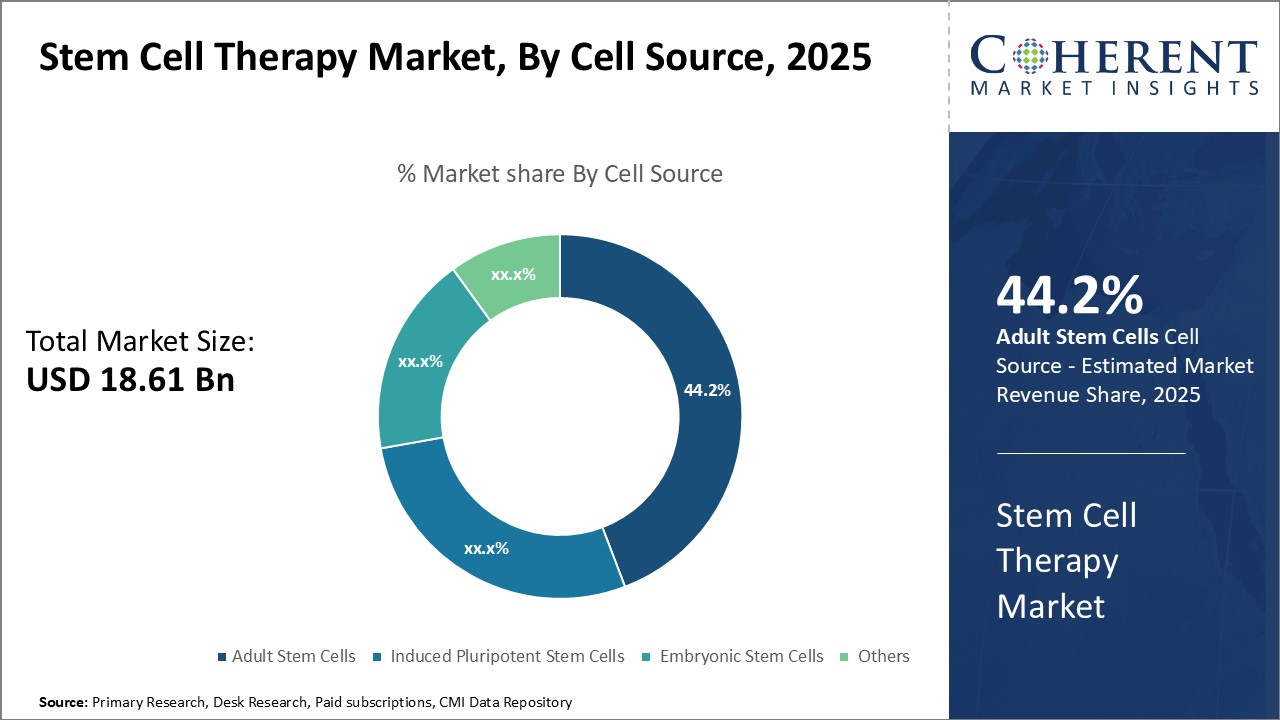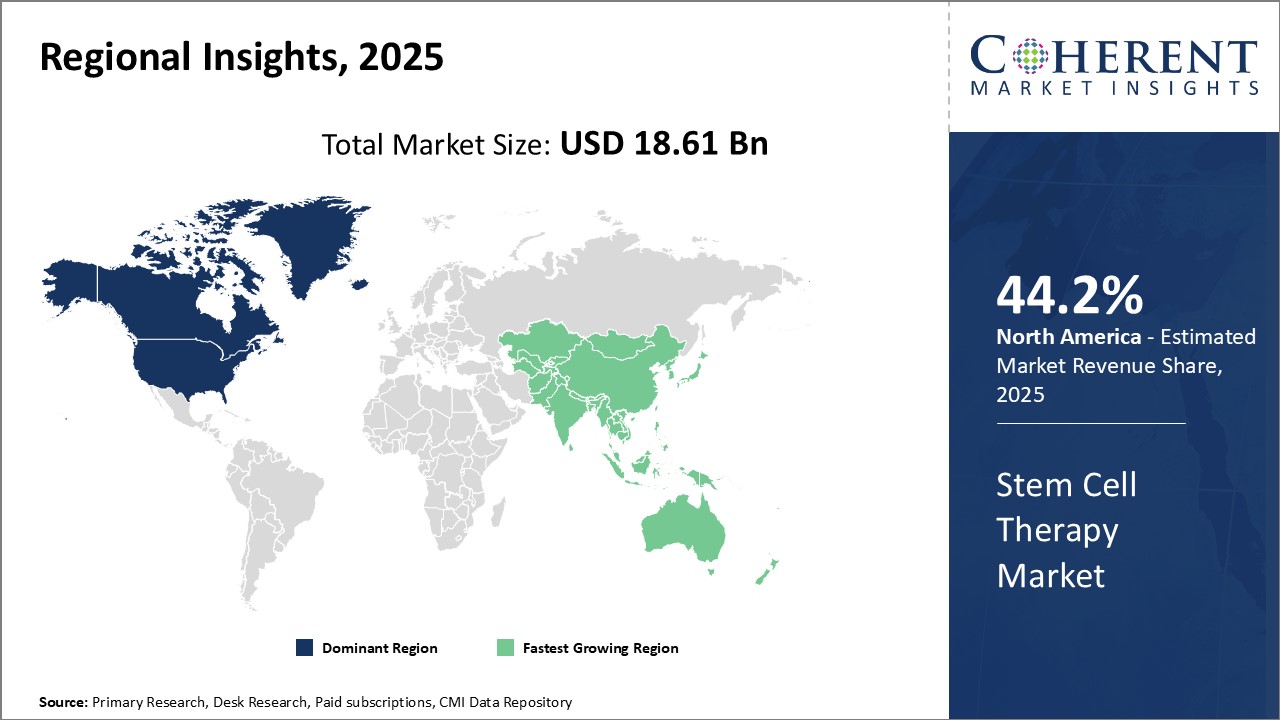Global stem cell therapy market is estimated to be valued at USD 18.61 Bn in 2025 and is expected to reach USD 78.39 Bn by 2032, exhibiting a compound annual growth rate (CAGR) of 22.8% from 2025 to 2032.

Discover market dynamics shaping the industry: Request sample copy
Stem cell therapy has witnessed huge adoption in recent years, owing to advancement in regulatory framework governing stem cell research and clinical applications. Rising prevalence of chronic diseases and success of stem cell based therapies to treat conditions such as cancer and blood disorders can drive the market growth. Furthermore, increasing public-private investments to develop innovative stem cell solutions for diseases like myocardial infarction can drive the stem cell therapy market growth during the forecast period. The number of clinical trials involving stem cells has significantly increased in the last few years, indicating the promise of this approach for both rare and common diseases. This is anticipated to provide new opportunities and drive future demand.
Increasing Manufacturing Facility Expansion by Key Market Players
Increasing manufacturing facility expansion by key market players is expected to drive the global stem cell therapy market growth over the forecast period. For instance, in October 2023, Bayer AG, a global pharmaceutical company, announced the opening of its first cell therapy facility in California, U.S., to create the capacity to bring cell therapies to patients on a global scale.

Get actionable strategies to beat competition: Request sample copy
Increasing Inorganic Growth Strategies among Key Market PlayersIncreasing adoption of inorganic growth strategies such as partnerships by key market players is expected to drive the market growth over the forecast period. For instance, in June 2022, The Melbourne node of the Novo Nordisk Foundation Center for Stem Cell Medicine (reNEW) announced a partnership with Murdoch Children's, the University of Copenhagen, and Leiden University Medical Center in the Netherlands, for stem cell research that will develop new treatments for cancer, diabetes and heart disease has been launched at the Murdoch Children’s Research Centre (MCRI).
Key Takeaways of Analyst:
Global stem cell therapy market growth is driven by rising prevalence of chronic diseases and growing awareness, demand for stem cell treatments. Advanced cell therapy technologies and falling treatment costs will further propel market expansion. However, stringent regulations can hamper clinical research slightly. Ethical concerns surrounding embryonic stem cells may impede market growth to an extent.
North America currently dominates the stem cell therapy landscape and is expected to remain the largest market during the forecast period. Presence of advanced healthcare infrastructure, high clinical research budgets, and supportive regulatory environment make the region highly favorable for stem cell treatment. Asia Pacific is likely to witness the fastest growth and emerge as a key market in the near future. Rising geriatric population, growing healthcare expenditure, and improving regulatory approval process in Asia Pacific countries are driving the market growth.
While stem cell therapies for musculoskeletal disorders form a mature segment, therapies targeting cardiac disorders indicate strongest potential. Increasing R&D focus on developing stem cell therapies for cancer, diabetes, and neurodegenerative diseases will open up new avenues for market players. Autologous stem cell therapies are expected to remain the preferred treatment method compared to allogeneic alternatives.
Market Challenge – Limited Awareness Regarding Treatment Options
Limited awareness regarding treatment options and the ethical concerns related to embryonic stem cells can hamper the market growth. For instance, according to the data published by the National Center for Biotechnology Information, there is main factor concerning is the fear of the unknown therapy and lack of awareness among the population about the treatment options. Moreover, high cost for these therapies leads to lower adoption, thus, leading to reduced demand for the product worldwide.
Market Opportunity – Potential Applications in New Therapeutic Areas
Potential applications in new therapeutic areas can offer significant opportunities for growth of global stem cell therapy market. Stem cell therapy holds promise for treating various diseases that currently have limited therapeutic options. Researchers worldwide are engaged in developing novel stem cell-based treatments for conditions such as neurodegenerative disorders, cardiovascular diseases and diabetes. According to World Health Organization, stroke is a leading cause of disability and the second leading cause of death worldwide. Cell therapy using stem cells is being investigated for its potential to treat stroke and regenerate damaged brain tissue. Several clinical studies are underway evaluating the safety and efficacy of stem cells for ischemic stroke. Promising results from early studies suggest stem cells may improve neurological outcomes when administered shortly after a stroke. Continued research aims to enhance the therapeutic potential for conditions with high unmet needs like stroke. As research expands into new areas, it is expected to drive significant growth of global stem cell therapy market. Continuous technological advancements to enhance the therapeutic potential of stem cells across different disease areas will promote their clinical adoption. This will pave the way for stem cell-based treatments to benefit millions suffering from diseases lacking effective cures.

Discover high revenue pocket segments and roadmap to it: Request sample copy
Insights, By Cell Source: Advancements in isolation techniques can drive adult stem cells segment growthCell Source segment is sub-segmented adult stem cells, induced pluripotent stem cells, embryonic stem cells, and others. Adult stem cells segment is estimated to hold 44.2% of the market share in 2025 owing to significant advancements in isolation techniques. Adult stem cells can be extracted from various tissues such as bone marrow, blood, skin and muscles. Unlike embryonic stem cells, their usage does not involve any ethical issues. Moreover, adult stem cells are more specialized than embryonic stem cells and can differentiate into a smaller number of cell types. Continuous research over the past decade has led to refined isolation protocols for extracting adult stem cells with high purity levels from different sources, and this has augmented their therapeutic applications. Banked adult stem cells can also be utilized for allogeneic transplantations, if matching tissue or cell types are available.
Insights, By Application: Growing prevalence of musculoskeletal disorders boosts skeletal applications
Application segment is sub-segmented musculoskeletal disorders, wounds and injuries, cancer, autoimmune disorders, and others. Musculoskeletal disorders segment is estimated to hold 39.7% of the market share in 2025, owing to growing prevalence of conditions such as osteoarthritis and bone fractures globally. Skeletal applications of stem cells including cartilage and bone regeneration are gaining popularity due to advantages such as enhanced recovery time, donor site morbidity reduction and ability of stem cells to augment the healing process. With ageing demographics and rising incidence of osteoporosis in developed nations, there will be increase in demand for stem cell therapies in orthopedics.
Insights, By End User: Hospitals lead uptake due to reimbursement and expertise
End User segment is sub-segmented into hospitals, cell banks, academic and research institutes. Hospitals segment is estimated to hold 33.1% of the market share in 2025 due to existing reimbursement policies and clinical expertise for stem cell procedures. While cell therapy products are still under regulatory approvals, several medical insurance plans provide partial to full coverage for procedures performed in hospitals. This makes stem cell treatment affordable for a larger patient base. Moreover, trained paramedics, sterile facilities and emergency care provisions allow hospitals to minimize procedure-related risks. Cell expansion and processing expertise also enables translation of novel stem cell therapies developed in research institutes to clinical settings. Rising popularity of outpatient clinics and day care centers for stem cell administration is anticipated to supplement hospitals’ share in the near future. However, regulatory hurdles continue to limit stem cell applications to third-party commercial settings.

Need a Different Region or Segment? Customize now
North America remains the dominant region in the global stem cell therapy market and is estimated to hold 44.2% of the market share in 2025. The strong presence of leading biotechnology and pharmaceutical companies in the U.S. has led to significant investments in R&D activities related to stem cell research. Countries like the U.S. and Canada have a highly developed healthcare infrastructure and regulatory framework that encourages clinical trials. This has resulted in the U.S. FDA approving several stem cell therapies for various conditions. The availability of private and public insurance covering stem cell therapy procedures has further increased its adoption in the region.
Asia Pacific region has emerged as the fastest growing market due to factors such as improving healthcare infrastructure, increasing medical tourism and supportive government policies. Countries like China, India, South Korea and Japan are rapidly becoming global hubs for stem cell therapy. These have built state-of-the-art stem cell banks and therapy centers at much lower costs as compared to the developed West. The relatively lower costs have attracted patients from other parts of the world. The rise of medical tourism can also drive the market growth. Patients travel to these countries for affordable stem cell treatments that are not easily accessible or approved in their own countries. Local governments recognize the huge potential, and are offering various incentives to attract private investments and boost domestic production capabilities. South Korea has emerged as a global leader in umbilical cord blood banking. Stringent quality regulations have ensured international accreditation of clinics. The Asia Pacific region thus offers immense opportunities through a unique convergence of advanced healthcare research and affordable delivery of stem cell therapies.
Stem Cell Therapy Market Report Coverage
| Report Coverage | Details | ||
|---|---|---|---|
| Base Year: | 2024 | Market Size in 2025: | USD 18.61 Bn |
| Historical Data for: | 2020 To 2024 | Forecast Period: | 2025 To 2032 |
| Forecast Period 2025 to 2032 CAGR: | 22.8% | 2032 Value Projection: | USD 78.39 Bn |
| Geographies covered: |
|
||
| Segments covered: |
|
||
| Companies covered: |
Osiris Therapeutics, Inc., Kolon TissueGene, Inc., JCR Pharmaceuticals Co., Ltd., Anterogen Co. Ltd., Pharmicell Co., Inc., Stemedica Cell Technologies, Inc., Magellan, Medipost Co., Ltd, Athersys Inc., Biorestorative Therapies Inc., Brainstorm Cell Limited., ViaCyte Inc., Cellular Biomedicine Group, ANTEROGEN. C.O., LTD., NuVasive Inc., RTI Surgical, AlloSource |
||
| Growth Drivers: |
|
||
| Restraints & Challenges: |
|
||
Uncover macros and micros vetted on 75+ parameters: Get instant access to report
*Definition: Stem cell therapy, also known as regenerative medicine, promotes the repair response of diseased, dysfunctional or injured tissue using stem cells or their derivatives. It is the next chapter in organ transplantation and uses cells instead of donor organs, which are limited in supply. Stem cells are cells with the potential to develop into many different types of cells in the body. These serve as a repair system for the body. There are two main types of stem cells: embryonic stem cells and adult stem cells. Stem cells are divided into two major classes; pluripotent and multipotent. Pluripotent stem cells are replicating cells, which are derived from the embryo or fetal tissues. The pluripotent stem cells facilitate the development of cells and tissues in three primary germ layers such as mesoderm, ectoderm, and endoderm.
Share
Share
About Author
Nikhilesh Ravindra Patel is a Senior Consultant with over 8 years of consulting experience. He excels in market estimations, market insights, and identifying trends and opportunities. His deep understanding of the market dynamics and ability to pinpoint growth areas make him an invaluable asset in guiding clients toward informed business decisions. He plays a instrumental role in providing market intelligence, business intelligence, and competitive intelligence services through the reports.
Missing comfort of reading report in your local language? Find your preferred language :
Transform your Strategy with Exclusive Trending Reports :
Frequently Asked Questions
Joining thousands of companies around the world committed to making the Excellent Business Solutions.
View All Our Clients
US Reciprocal Tax Impact Analysis On Stem Cell Therapy Market
Stay updated on tariff changes with expert insights and timely information